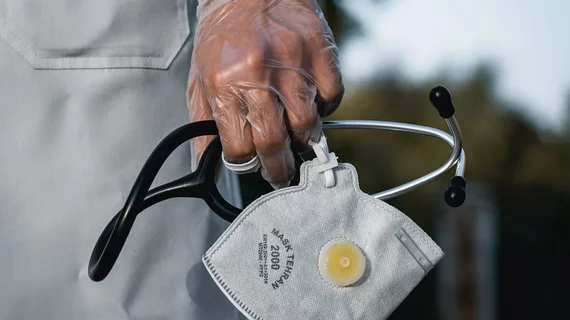Johns Hopkins radiologists are warning about the possibility of unsuspected COVID-19 pneumonia cases cropping up during routine imaging exams, and the need for greater PPE diligence in the coming months.
Experts from the Baltimore-based institution gave the examples of two recent encounters in which patients presented with no symptoms while undergoing CT scans for other reasons. Both ended up having the novel coronavirus, and Megan Lee et al. believe the specialty must remain hyper-vigilant as it works through the pandemic-induced backlog of imaging exams.
“It is incumbent upon radiology practices to take measures to protect their staff and patients in all practice settings,” Lee, and her MD colleagues wrote Saturday, Nov. 21, in Radiology Case Reports.
The authors gave the example of a 42-year-old woman who was scheduled for preoperative CT scans of the abdomen and pelvis at an outpatient center. Hopkins screened her by phone for symptoms the day before, while no temp check was performed at arrival. Technologists delivered the exam using face shields, surgical masks and gloves. And the incidental appearance of the virus on scans was later confirmed via lab testing.
In another instance, a 49-year-old woman presented at the emergency department with weakness, abdominal pain and nausea, among other symptoms. She denied having a fever, chills, chest pain or a cough and had no sick contacts. So, providers did not label her as under suspicion for the disease. Techs gathered scans using the same equipment as the first patient, and again suspicious CT findings led to an eventual positive lab test.
Lee and colleagues believe these cases underline the need for meticulous sanitizing measures between patients and diligent use of personal protective equipment. Screening for symptoms over the phone, while useful, will not prevent patients with the virus from showing up at outpatient centers or the ED, they said.
“As more patients present for elective imaging that was previously postponed, it remains important to maintain a high level of vigilance to curb the spread of the virus,” the team advised. “Given the negative outcomes with delaying care (medical and economic), institutions are now implementing other means to curb transmission rather than drastic reductions in services. Personnel that have close contact with asymptomatic patients should consider higher levels of PPE such as routine N95 use.”
Read more of their analysis in Radiology Case Reports here.

